Useful results, Definition, Illustration, Example Solved Problems | Geometry - Similar triangles | 10th Mathematics : UNIT 4 : Geometry
Chapter: 10th Mathematics : UNIT 4 : Geometry
Similar triangles
Similarity
Two figures are said to be similar if every aspect of one figure
is proportional to other figure. For example:
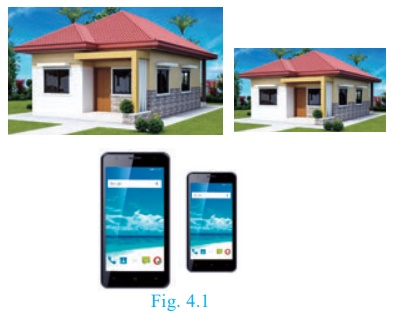
The above houses
look the same but different in size. Both the mobile
phones are the same but they vary in their sizes. Therefore,
mathematically we say that two objects are similar if they are of same shape
but not necessarily they need to have the same size. The ratio of the
corresponding measurements of two similar objects must be
proportional.
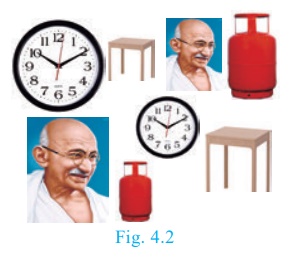
Here is a box of geometrical shapes. Collect the similar objects
and list out.
In this chapter, we will be discussing specifically the use of
similar triangles which is of utmost importance where if it is beyond our reach
to physically measure the distance and height with simple measuring instruments. The concept of similarity is widely used in the fields of engineering, architecture
and construction.
Here are few applications of similarity
(i) By analyzing the shadows that make triangles, we can
determine the actual height of the objects.
(ii) Used in aerial photography to determine the distance from sky
to a particular location on the ground.
(iii) Used in Architecture to aid in design of their work.
1. Similar triangles
In class IX, we have studied congruent triangles. We can say that
two geometrical figures are congruent, if they have same size and shape. But,
here we shall study about geometrical figures which have same shape but
proportional sizes. These figures are called “similar”.
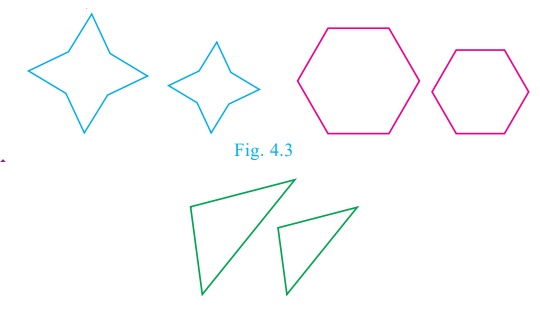
Congruency and similarity of triangles
Congruency is a particular case of similarity. In both the cases,
three angles of one triangle are equal to the three corresponding angles of the
other triangle. DABC DPQR But in congruent
triangles, the corresponding sides are equal. While in similar triangles, the
corresponding sides are proportional.
Note
The traingles ABC and PQR are similar can be
written as ΔABC ~ ΔPQR
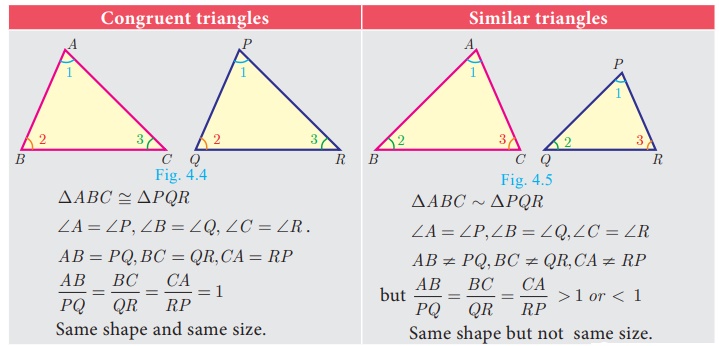
2. Criteria of Similarity
The following criteria are sufficient to prove that two triangles
are similar.
AA Criterion of similarity
If two angles of one triangle are respectively equal to two angles
of another triangle, then the two triangles are similar, because the third
angle in both triangles must be equal. Therefore, AA similarity criterion is same as the AAA similarity
criterion.
So if ∠A = ∠P = 1 and ∠B = ∠Q = 2 then ΔABC ~ ΔPQR.
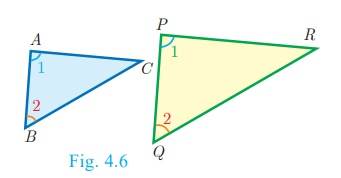
SAS Criterion of similarity
If one angle of a triangle is equal to one angle of another
triangle and if the sides including them are proportional then the two
triangles are similar.
Thus if ∠A = ∠P = 1 and
AB/PQ = AC/PR then ΔABC ~ ΔPQR.
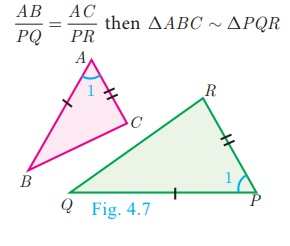
SSS Criterion of similarity
If three sides of a triangle are proportional to the three
corresponding sides of another triangle, then the two triangles are similar.
So if, AB /PQ = AC /PR = BC /QR then ΔABC ~
ΔPQR
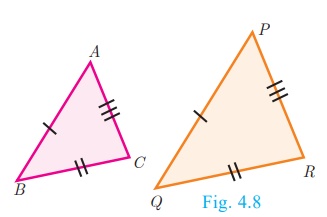
Thinking Corner: Are any two right angled triangles
similar? If so why?
Some useful results on similar triangles
1. A perpendicular line drawn from the
vertex of a right angled triangle divides the triangle into two triangles
similar to each other and also to original triangle.
ΔADB ~ ΔBDC, ΔABC ~ ΔADB,
ΔABC ~ ΔBDC
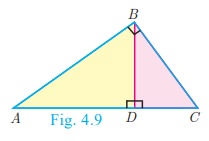
2. If two triangles are similar, then
the ratio of the corresponding sides are equal to the ratio of their
corresponding altitudes.
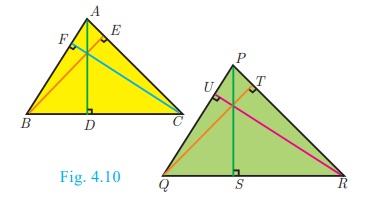
i.e. if ΔABC ~ ΔPQR then
AB/PQ = BC/QR = CA/RP = AD/PS = BE/QT =
CF/RU

3. If two triangles are similar, then
the ratio of C the corresponding sides
are equal to the ratio of the
corresponding perimeters.
ΔABC ~ ΔDEF then
AB/DE = BC/EF = CA/FD = [AB + BC +CA] /
[DE + EF + FD]
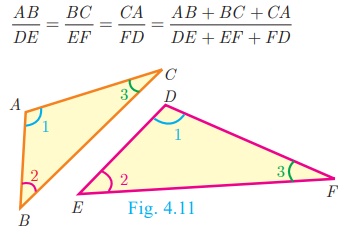
4. The ratio of the area of two similar
triangles are equal to the ratio of the squares of their corresponding sides.
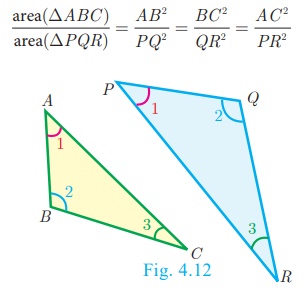
5. If two triangles have common vertex and their bases are on the same straight line, the ratio between their areas is equal to the ratio between the length of their bases.
Here, area( ABD) / area( BDC) = AD/DC
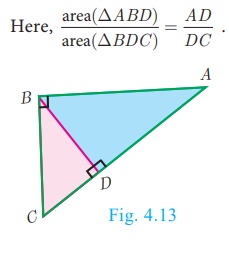
Definition 1
Two triangles are said to be similar if their corresponding
sides are proportional.
Definition 2
The triangles are equiangular if the corresponding angles are
equal.
Illustration
Two triangles, ΔXYZ and ΔLMN are similar because the corresponding angles are equal.
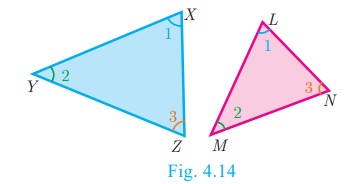
(i) ∠X = ∠L, ∠Y = ∠M,∠Z = ∠N (by angles)
(ii) XY/LM = YZ/MN = XZ/LN (by sides)
Here the vertices X, Y, Z correspond to the vertices L,
M, N respectively. Thus in symbol ΔXYZ ~ ΔLMN
Note
(i) A pair of equiangular triangles are similar.
(ii) If two triangles are similar, then they are equiangular.
Example 4.1
Show that ΔPST ~ ΔPQR
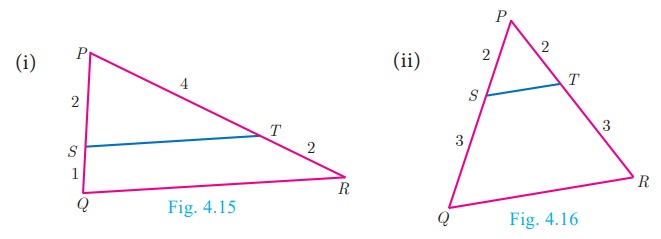
Solution
(i) In ΔPST and ΔPQR ,

Thus,  and ∠P is common
and ∠P is common
Therefore, by SAS similarity, ΔPST ~ ΔPQR
(ii) In ΔPST and ΔPQR ,

Thus,  and ∠P is common
and ∠P is common
Therefore, by SAS similarity,
ΔPST ~ ΔPQR
Example 4.2
Is ΔABC ~ ΔPQR ?
Solution
In ΔABC and ΔPQR ,
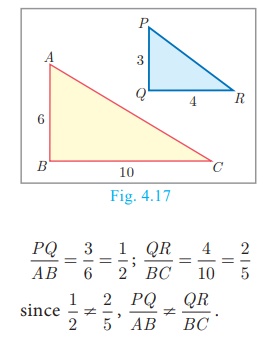
The corresponding sides are not proportional.
Therefore ΔABC is not similar to ΔPQR
Note
If we change exactly one of the four given lengths, then we can
make these triangles similar.
Example 4.3
Observe Fig.4.18 and find ∠P .
Solution
In ΔBAC and ΔPRQ , AB/RQ = 3/6 = 1/2;
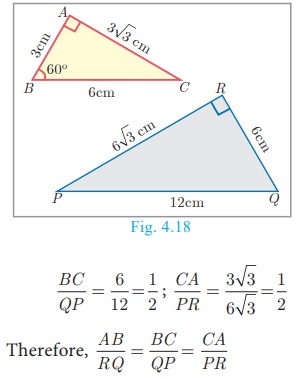
Therefore, AB/RQ = BC/QP = PR/CA
By SSS similarity, we have Δ BAC ~ ΔQRP
∠P = C (since the
corresponding parts of similar triangle)
∠P = C = 180°−
(∠A + ∠B) = 180° −
(90° + 60°)
∠P = 180° − 150° =
30°
Example 4.4
A boy of height 90cm is walking away from the base of a lamp post at a speed of 1.2m/sec. If
the lamppost is 3.6m A above the ground, find the length
of his shadow cast after 4 seconds.
Solution
Given, speed = 1.2 m/s,
time = 4 seconds
distance = speed × time = 1.2×4 = 4.8 m
Let x be the length of the shadow after 4 seconds
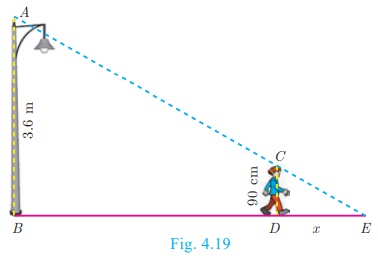
Since, Δ ABE ~ ΔCDE ,  = 4
(since 90 cm = 0.9 m)
= 4
(since 90 cm = 0.9 m)
4.8 + x =4x gives 3x =4.8 so, x =1.6 m
The length of his shadow DE = 1.6 m
Example 4.5
In Fig.4.20 ∠A = ∠CED prove that ΔCAB ~ ΔCED. Also find the value
of x.
Solution
In ΔCAB and ΔCED , ∠C is common, ∠A = CED
Therefore, ΔCAB ~ ΔCED (By AA similarity)

Example 4.6
In Fig.4.21, QA and PB are perpendiculars to AB. If AO = 10 cm, BO= 6 cm and PB= 9 cm.
Find AQ.
Solution
In ΔAOQ and ΔBOP , ∠OAQ = OBP = 90°
∠AOQ = BOP (Vertically
opposite angles)
Therefore, by AA Criterion of similarity, ΔAOQ ~
ΔBOP
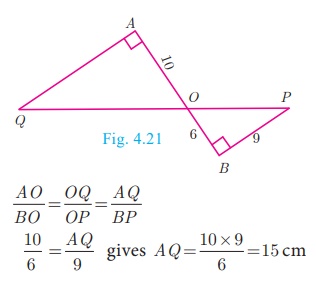
Example 4.7
The perimeters of two similar triangles ABC respectively 36 cm and
24 cm. If PQ = 10 cm, find AB.
Solution
The ratio of the corresponding sides of similar triangles is same
as the ratio of their perimeters.
Since ΔABC ~ ΔPQR ,
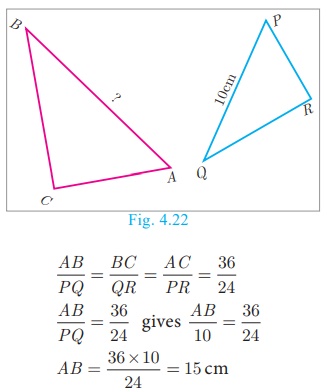
Example 4.8
If ΔABC is similar to ΔDEF such that BC= 3
cm, EF= 4 cm and area of ΔABC = 54 cm2. Find the area
of ΔDEF .
Solution
Since the ratio of area of two similar triangles is equal to the
ratio of the squares of any two corresponding sides, we have

Example 4.9
Two poles of height ‘a’ metres and ‘b’ metres are ‘p’
metres apart. Prove that the height of the point of intersection of the lines
joining the top of each pole to the foot of the opposite pole is given by ab / a+b
metres.
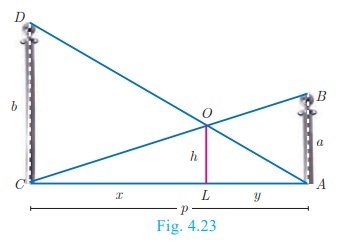
Solution
Let AB and CD be two poles of height ‘a’ metres and ‘b’ metres respectively such that the poles are ‘p’ metres apart. That is AC= p metres. Suppose the lines AD and BC meet at O, such that OL= h metres
Let CL = x and LA = y.
Then, x + y = p
In ΔABC and ΔLOC , we have
∠CAB = ∠CLO [each equal to 90° ]
∠C = ∠C [C is common]
ΔCAB ~ ΔCLO [By AA similarity]

In ΔALO and ΔACD , we have
∠ALO = ACD [each equal
to 90° ]
∠A = ∠A [A is common]
Δ ALO ~ ΔACD [by AA similarity]
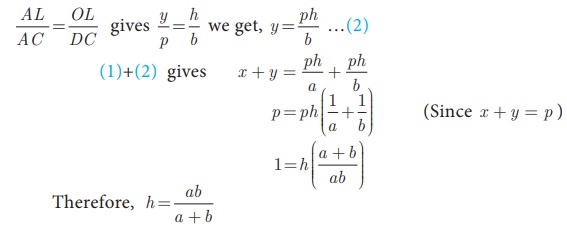
Therefore, h = ab / a+b
Hence, the height of the intersection of the lines joining the top of each pole to the foot of the opposite pole is ab / a+b metres.
3. Construction of similar triangles
So far we have discussed the theoretical approach of similar
triangles and their properties. Now we shall discuss the geometrical
construction of a triangle similar to a given triangle whose sides are in a
given ratio with the corresponding sides of the given triangle.
This construction includes two different cases. In one, the
triangle to be constructed is smaller and in the other it is larger than the
given triangle. So, we use the following term called “scale factor” which
measures the ratio of the sides of the triangle to be constructed with the
corresponding sides of the given triangle. Let us take the following examples
involving the two cases:
Example 4.10
Construct a triangle similar to a given triangle PQR with its
sides equal to 3/5 of the corresponding sides of the triangle PQR (scale factor
3/5 < 1)
Solution
Given a triangle PQR we are required to construct another triangle
whose sides are 3/5 of the corresponding sides of the triangle PQR.
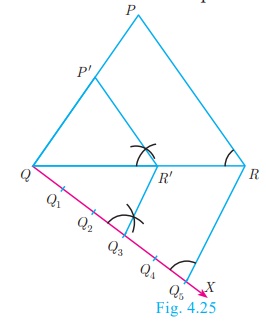
Steps of construction
1. Construct a ΔPQR with any measurement.
2. Draw a ray QX making an acute angle with QR on
the side opposite to vertex P.
3. Locate 5 (the greater of 3 and 5 in 3/5 ) points.
Q1, Q2 ,Q 3 ,Q4
and Q5 on QX so that QQ1
= Q1Q2 = Q2Q3
= Q 3Q4 = Q 4Q5
4. Join Q5 R and draw a line through Q3
(the third point, 3 being smaller of 3 and 5 in 3/5 ) parallel to Q5
R to intersect QR at R¢ .
5. Draw line through R’ parallel to the line RP to
intersect QP at P’.
Then, ΔP’QR is the required triangle each of whose sides is three-fifths of the corresponding sides of ΔPQR .
Example 4.11
Construct a triangle similar to a given triangle PQR with
its sides equal to 7/4 of the corresponding sides of theP triangle PQR
(scale factor 7/4 > 1)
Solution
Given a triangle PQR, we are required construct another triangle
whose sides are 7/4 of the corresponding sides of the triangle PQR.
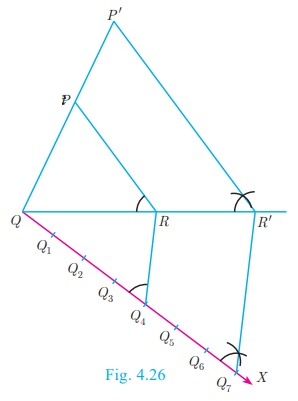
Steps of construction
1. Construct a ΔPQR with any measurement.
2. Draw a ray QX making an acute angle with QR on
the side opposite to vertex P.
3. Locate 7 points (the greater of 7 and 4 in 7/4)
Q1, Q2 ,Q 3 ,Q4,Q5,Q6
and Q7 on QX so that
QQ1 = Q1Q2 = Q2Q3
= Q 3Q4 = Q 4Q5
= Q5Q6 = Q6Q7
4. Join Q4 (the 4th point, 4 being smaller of 4
and 7 in 7/4 ) to R and draw a line through
Q7 parallel to Q 4 R, intersecting the
extended line segment QR at R’.
5. Draw a line through R’ parallel to RP
intersecting the extended line segment QP at P’.
Then ΔP′QR′ is the required triangle each of whose
sides is seven-fourths of the corresponding sides of ΔPQR .
Related Topics